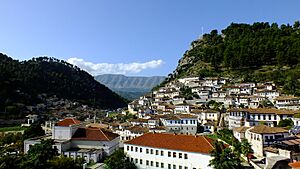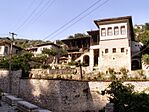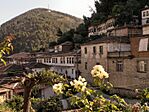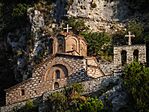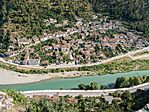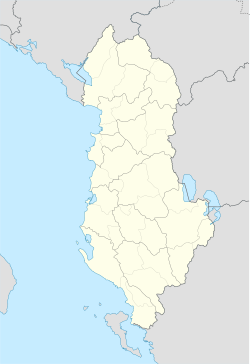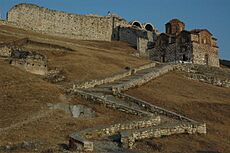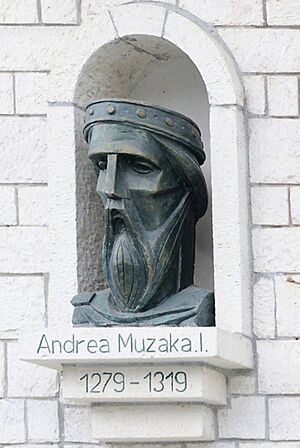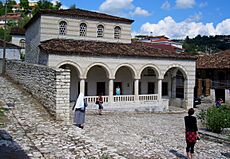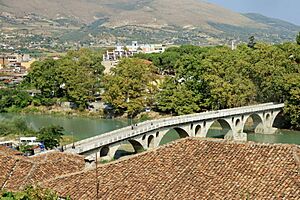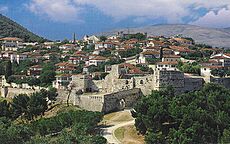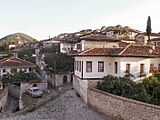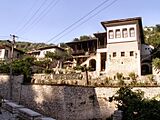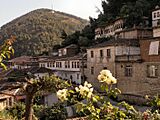Berat facts for kids
Quick facts for kids
Berat
|
|||
|---|---|---|---|
|
Photomontage of Berat
|
|||
|
|||
| Country | |||
| County | Berat | ||
| Area | |||
| • Municipality | 380.21 km2 (146.80 sq mi) | ||
| Elevation | 80 m (260 ft) | ||
| Population
(2011)
|
|||
| • Municipality | 60,031 | ||
| • Municipality density | 157.889/km2 (408.931/sq mi) | ||
| • Municipal unit | 36,496 | ||
| Demonym(s) | Albanian: Beratas (m), Beratase (f) | ||
| Time zone | UTC+1 (CET) | ||
| • Summer (DST) | UTC+2 (CEST) | ||
| Postal Code |
5001-5022
|
||
| Area Code | (0)11 | ||
| Website | |||
| Official name: Historic Centres of Berat and Gjirokastra | |||
| Type: | Cultural | ||
| Criteria: | iii, iv | ||
| Designated: | 2005 | ||
| Reference #: | 569 | ||
| Region: | Berat County | ||
| Europe: | 2005–present | ||
| Historical population | ||
|---|---|---|
| Year | Pop. | ±% |
| 1950 | 11,648 | — |
| 1955 | 14,374 | +23.4% |
| 1960 | 18,685 | +30.0% |
| 1969 | 24,700 | +32.2% |
| 1979 | 33,400 | +35.2% |
| 1989 | 42,957 | +28.6% |
| 2001 | 40,072 | −6.7% |
| 2011 | 36,496 | −8.9% |
| Source: pop-stat.mashke.org | ||
Berat is a famous city in Albania. It is the ninth largest city in the country. Berat is the main city of Berat County and the Berat Municipality.
The city is about 70 kilometers (43 miles) south of Tirana, the capital of Albania. It is surrounded by mountains and hills. To the east, you can see Tomorr mountain, which is now a national park. The Osum River flows through Berat before joining the Seman River.
Berat is a UNESCO World Heritage Site. This means it is a very special place with a unique style of buildings. Its architecture shows influences from many different cultures that have lived there over hundreds of years. Like many Albanian cities, Berat has an old, strong city with churches and mosques. These buildings are decorated with amazing murals and frescos. Berat is one of Albania's most important cultural centers.
Contents
What's in a Name?
The name Berat comes from an old Slavic word, Bělgrad. This word means "White City."
Long ago, people believed Berat was the ancient city of Antipatreia. This name might have come from Antipater, a general from Macedon. Later, during the early Byzantine Empire, the city was called Pulcheriopolis. This name meant "City of Pulcheria," who was an empress.
Over time, the city had many names. In Medieval Latin, it was Belogradum. In Turkish, it was Belgrad. In Italian, it was Belgrado. The Republic of Venice called it Belgrado di Romania. The Ottoman Empire called it Belgrad-i Arnavud (Albanian Belgrade) to tell it apart from Belgrade in Serbia. Today, in the Aromanian language, Berat is known as Birat.
A Look Back in Time
Early Days
People first settled on the rocky hill of Berat around 700 BCE. These early settlers were the Illyrians. Berat is thought to be the ancient city of Antipatrea. This city was likely founded after Cassander of Macedon took control of southern Illyria around 314 BCE.
Antipatrea was part of important wars, like the Illyrian Wars and Macedonian Wars. It was known as a city of Dassaretia in southern Illyria. In 200 BCE, the Romans attacked and destroyed parts of the city. Later, it became part of the Byzantine Empire. During this time, it was called Pulcheriopolis.
In the 9th century, the First Bulgarian Empire took over the town. This is when it got its Slavic name, Bel[i]grad, meaning "White City." This name stuck through the Middle Ages. In 1018, the city went back to Byzantine control. Then, in 1203, the Second Bulgarian Empire took it again. In the 13th century, it was ruled by Michael I Ducas from the Despotate of Epirus.
In 1272, the Byzantine Emperor Michael VIII Palaiologos tried to get Albanian leaders in Berat to join him against Charles I of Naples. But the leaders stayed loyal to Charles. In 1274, Michael VIII took Berat back. Later, in 1280-1281, forces from Sicily tried to capture Berat. But a relief army from Constantinople helped defend the city. Berat went back to Byzantine control later in the 13th century.
In 1337, Albanian tribes living near Berat rebelled and took the fortress of Tomorr. The Byzantine emperor defeated them. Around 1345, the town became part of the Serbian Empire. After this empire broke apart in 1355, Berat was ruled by local leaders like John Komnenos Asen. In 1385, the Ottoman Empire captured Berat. By 1396, the Albanian Muzaka family took control, making Berat the capital of their own Principality of Berat. But in 1417, Berat became part of the Ottoman Empire. In 1455, Skanderbeg, a famous Albanian commander, tried to take Berat back from the Ottomans but was not successful.
Modern Times
During the early Ottoman rule, Berat faced hard times. By the late 1500s, it had only 710 houses. But it started to get better in the 1600s and became a big center for crafts, especially wood carving.
In the early 1500s, Berat was a Christian city. A Jewish community also lived there, with about 25 families. Later in the 1500s, many people in Berat became Muslim. This was partly because Muslim craftsmen didn't have to pay as many taxes if they served in the military.
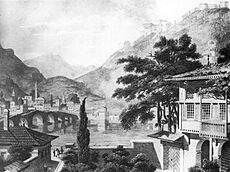
By the early 1600s, Berat became a city where most people were Muslim. In the 1700s, Berat was one of the most important Albanian cities under Ottoman rule. It even became the capital of the Pashalik of Berat, a local state.
In the 1800s, Berat played a big role in the Albanian national revival. This was a time when Albanians worked to gain their independence. Christian merchants in Berat supported this movement. There were several revolts in the city. In October 1833, people in Berat demanded that Albanians should lead their local government. The Ottoman government agreed to some of these demands. In August 1839, another uprising happened, and rebels took the castle.

Berat was a strong supporter of the League of Prizren, an Albanian nationalist group in the late 1800s. During the First World War, many Orthodox Christians and Muslims lived in the Berat region.
20th and 21st Century
During the Second World War, many Jewish people were hidden in the homes of Muslim and Christian families in Berat. Albanian Muslims even let Jewish people pray in the local mosque. A Star of David can still be seen on the walls of the city's main mosque.
In October 1944, an important meeting was held in Berat. The Anti-Fascist National Liberation Committee became the Provisional Democratic Government of Albania. Enver Hoxha became its prime minister.
Today, a Romani community lives in Berat. There are also some people who speak Aromanian and Greek in the town and nearby villages.
Where is Berat?
Berat is located on the right side of the Osum River. The old city has three main parts: Kalaja (on the castle hill), Mangalem (at the bottom of the castle hill), and Gorica (on the left side of the Osum River). The city has many old and interesting buildings. The tall Tomorr mountains with their pine forests make a beautiful background. The Osum River has carved a deep gorge, making a natural fortress where the town was built.
There's a legend in Albania about the Tomorr mountain. It says that Tomorr was a giant who fought with another giant named Shpirag over a young woman. They both died, and the girl cried so much that her tears became the Osum River.
Mount Shpirag, named after the second giant, is on the left side of the gorge. Berat is often called the "City of One Above Another Windows" because of the many large windows on its old houses. It was declared a 'Museum City' in 1961.
Weather in Berat
Berat has a Mediterranean climate. This means it has hot and dry summers. July is usually the hottest month. Winters are mild and wet. January is the coldest month. The highest temperature ever recorded in Berat was about 47.1°C (116.8°F), and the lowest was about -12.2°C (10.0°F).
| Climate data for Berat (1991 - 2010) | |||||||||||||
|---|---|---|---|---|---|---|---|---|---|---|---|---|---|
| Month | Jan | Feb | Mar | Apr | May | Jun | Jul | Aug | Sep | Oct | Nov | Dec | Year |
| Record high °C (°F) | 25 (77) |
27 (81) |
29 (84) |
34 (93) |
38 (100) |
43 (109) |
44 (111) |
43 (109) |
42 (108) |
35 (95) |
30 (86) |
28 (82) |
44 (111) |
| Mean daily maximum °C (°F) | 14.4 (57.9) |
15.3 (59.5) |
17.1 (62.8) |
22 (72) |
25.3 (77.5) |
30.4 (86.7) |
33.4 (92.1) |
33.6 (92.5) |
29.2 (84.6) |
24 (75) |
20 (68) |
15.8 (60.4) |
23.4 (74.1) |
| Mean daily minimum °C (°F) | 2.0 (35.6) |
2.1 (35.8) |
4.2 (39.6) |
10 (50) |
13 (55) |
17.8 (64.0) |
20.3 (68.5) |
20.0 (68.0) |
17.0 (62.6) |
12.5 (54.5) |
9.3 (48.7) |
3.5 (38.3) |
11.0 (51.7) |
| Record low °C (°F) | −10 (14) |
−9 (16) |
−4 (25) |
−1 (30) |
3 (37) |
8 (46) |
14 (57) |
12 (54) |
6 (43) |
0 (32) |
−3 (27) |
−8 (18) |
−10 (14) |
| Average precipitation mm (inches) | 145 (5.7) |
152 (6.0) |
108 (4.3) |
97 (3.8) |
65 (2.6) |
20 (0.8) |
4 (0.2) |
5 (0.2) |
30 (1.2) |
80 (3.1) |
190 (7.5) |
198 (7.8) |
1,094 (43.2) |
| Source: METEOALB Weather Station | |||||||||||||
What Berat Makes
In the 1700s, Berat's economy was very connected to its craft guilds. These were groups of skilled workers. There were 22 guilds, with leather workers, shoemakers, and tanners being the most important. Other guilds worked with metal, silver, and silk.
Today, Berat is home to Albania's military industry. It has the Kuçovë base and the Poliçan factory nearby. Also, tourism is growing thanks to the city's many historical sites.
Culture and Landmarks
Famous Places to See
Berat shows how different religious and cultural groups lived together for centuries. The city also has amazing examples of traditional Balkan houses from the late 1700s and 1800s. Some famous landmarks include the Berat Castle, old Byzantine churches, the Bachelors' Mosque, the National Ethnographic Museum, the Sultan's Mosque, the Lead Mosque, and the Gorica Bridge.
The Berat Castle sits on a rocky hill by the Osum River. It can only be reached from the south. After being burned by the Romans in 200 BCE, its walls were made stronger many times. The buildings inside the castle were built in the 1200s and are kept as cultural treasures. Many Christians lived in the castle, and it had about 20 churches. There was only one mosque for the Muslim soldiers.
The Church of St. Mary of Blachernae is from the 1200s. It has beautiful wall paintings from the 1500s by Nikollë Onufri, the son of a famous Albanian painter named Onufri. Inside the castle walls, you can also find the 1300s Church of the Holy Trinity. It has a cross shape and Byzantine wall paintings. Outside the castle walls is the Church of St. Michael (Shën Mehill), built in the 1200s.
Near the entrance to the castle is the small Church of St. Theodore (Shen Todher). It has wall paintings by Onufri himself. The most interesting church is the cathedral of St. Nicholas, which is now a museum dedicated to Onufri. Onufri was one of the greatest painters of the 1500s in Albania. He was known for using a special shiny red color. He also made faces in his paintings look more real and individual.
Onufri's painting style was passed down to his son, Nikolla, but his son was not as famous. In the Onufri museum, you can see works by Onufri, his son, and other painters. There are also many icons and beautiful silver religious items. The Berat Gospels, which are copies of very old books from the 300s, are also there.
Near the street from the castle is the Bachelors' Mosque (Xhami e Beqareve), built in 1827. It has a porch and pretty decorations of flowers and plants. The "Bachelors" were young shop assistants who acted as a private guard for merchants.
The King Mosque (Xhamia e Mbretit) is the oldest mosque in Berat. It was built between 1481 and 1512 and is known for its beautiful ceiling. Today, it is a museum.
The Lead Mosque (Xhamia e Plumbit) was built in 1555. It gets its name from the lead covering its dome. This mosque is in the center of the town.
The Halveti Tekke (Teqe e Helvetive) was likely built in the 1400s and rebuilt in 1782. It belongs to a Sufi group called the Khalwati order.
Near the tekke, some believe is the grave of Sabbatai Zevi. He was an Ottoman Jew who caused a stir when he converted to Islam.
There is also a Jewish history museum in Berat called the "Solomon Museum." It shows how Jewish people survived the Holocaust in Albania during the war.
Berat is famous for its old buildings and views. It's known as the "Town of a Thousand Windows" because of the many large windows on its old houses. It's not clear if it means "Thousand" or "One over Another" windows. The houses are built on a very steep hill, so the windows look like they are stacked on top of each other.
The Citadel (castle) looks over the river and the modern city. It's a well-preserved area with narrow streets, old Turkish houses, and Orthodox churches.
Modern Berat has three parts divided by the Osum River: Gorica, Mangalem, and Kalaja. Kalaja is a living area inside the old Byzantine castle. The town also has a 15th-century mosque and several churches of the Albanian Orthodox Church. Many of these churches have artworks by the famous 16th-century painter Onufri.
The Berat National Ethnographic Museum opened in 1979. It has many everyday items from Berat's history. You can see old furniture, wooden cases, wall-closets, chimneys, and even an olive press. These items show what daily life was like for people in Berat long ago. The ground floor has a model of a medieval street with traditional shops. The second floor has an archive, a loom, and rooms showing how people lived.
The Gorica Bridge connects the two parts of Berat. It was first built from wood in 1780 and then rebuilt with stone in the 1920s. This bridge has seven arches and is about 129 meters (423 feet) long. It stands about 10 meters (33 feet) above the river. A local legend says the original wooden bridge had a dungeon where a girl was kept to make sure the bridge stayed safe.
Learning in Berat
Berat has secondary schools. It also used to have a private university called the Albanian University in Berat, but its programs ended in 2019.
Sports
The city's main football (soccer) club is KS Tomori Berat.
Partner Cities
Berat is connected with these cities around the world:
 Amasya, Amasya Province, Turkey
Amasya, Amasya Province, Turkey Bağcılar, Istanbul, Turkey
Bağcılar, Istanbul, Turkey Bérat, Occitania, France
Bérat, Occitania, France Fermo, Marche, Italy
Fermo, Marche, Italy Karmiel, Northern District, Israel
Karmiel, Northern District, Israel Lovech, Lovech Province, Bulgaria
Lovech, Lovech Province, Bulgaria Ploiești, Muntenia, Romania
Ploiești, Muntenia, Romania Prizren, Prizren District, Kosovo
Prizren, Prizren District, Kosovo Ulcinj, Montenegro
Ulcinj, Montenegro
Famous People from Berat
- Omer Pasha Vrioni II – An Albanian leader who founded the city of Fier.
- Christopher of Albania – A leader of the Albanian Orthodox Church.
- Eni Koçi – A female singer.
- Sotir Kolea – A folklorist and diplomat who helped with the Albanian National Awakening.
- Afërdita Veveçka Priftaj – A physicist.
- Myrto Uzuni – A professional football player for Granada and the Albania national football team.
- Aziz Vrioni – An Ottoman-Albanian politician.
- Iliaz Vrioni – A politician who was Prime Minister of Albania three times.
- Isuf Vrioni – A translator and diplomat.
- Omer Vrioni – An Ottoman figure in the Greek War of Independence.
- Sami Bey Vrioni – A politician and diplomat.
- Dhimitër Tutulani – A lawyer and politician.
- Kasëm Trebeshina – A writer and actor.
- Margarita Tutulani – An anti-fascist hero of Albania during World War II.
- Constantine of Berat – An Albanian poet from the 1700s.
- Aleksander Meksi – A former prime minister of Albania.
- Sulejman Naibi – An Albanian poet.
- Vexhi Buharaja – An Albanian writer and translator.
- Agim Shuka – A famous Albanian film and stage actor.
- Orli Shuka – A British-Albanian actor known for his role in Gangs of London.
- Dhimitër Beratti – An Albanian politician and journalist, one of the people who signed the Albanian Declaration of Independence.
- Babë Dudë Karbunara – A teacher and politician, also a signatory of the Albanian Declaration of Independence.
Images for kids
See also
 In Spanish: Berat para niños
In Spanish: Berat para niños


